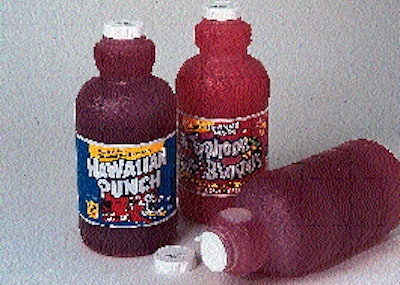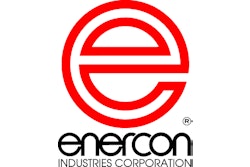Procter & Gamble Co. (Cincinnati, OH) has used both bottle structures for its Hawaiian Punch fruit drinks. But now, citing economics and environmental issues, P&G is debuting a third plastic bottle option for shelf-stable juices: high-density polyethylene/EVOH/HDPE. The company is dropping stock 64-ounce, clear PET bottles of "Fruit Juicy Red" and "Typhoon Blasters Stormin' Tropical Strawberry" Hawaiian Punch in favor of a trademarked, textured surface HDPE/EVOH/HDPE decanter. Gone, too, are the 128-ounce PP/EVOH/PP jugs of Hawaiian Punch favored by club stores. They've been replaced by containers made from the new structure. Both of the new bottles are extrusion blowmolded by Continental Plastic Containers (Norwalk, CT). Injection-molded PP caps from Phoenix Closures (Naperville, IL), PP/foil membrane inner seals from Unipak, Inc. (Aurora, Ontario, Canada) and reverse-printed foamed PP labels finish off the new Hawaiian Punch look. While P&G is releasing few production details on its new bottles, their primary material and lack of vacuum panels suggest they are cold filled. Sources indicate that bottles are induction sealed at 400+/min on units from Enercon Industries Corp. (Menomonee Falls, WI). To encourage recycling, P&G's new bottles carry an "HDPE/2" resin identification code, not an "Other/7" code, despite the EVOH content. That's because the containers are meant to be recycled in the HDPE stream. Economics, we're told, was a driving force behind the switch to HDPE/EVOH/HDPE bottles. This suggests that P&G buyers, not known as spendthrifts, expect PET prices to move back up toward their late 1994 levels when the Hawaiian Punch conversion to HDPE first got underway. Lower price is most appealing beverage packaging feature Carbonated soft drinks (CSD) in the United States last year consumed some 67 billion aluminum cans. A truism that canmakers face in the ever-competitive CSD market is that innovation appeals, but price sells. That may explain why Crown Cork & Seal Co., Inc. (Philadelphia, PA) is paying ACX Technologies, Inc. (Golden, CO) $10 million for an option to buy the mini-mill can sheet production operations of its Golden Aluminum Co. (Golden, CO) sometime within the next two years. Crown says the $10 million option "will enable us to expand the potential for mini-mill technology." If it decides to exercise the option, Crown will buy "substantially all" of Golden Aluminum Co. (GAC), with ACX retaining a minority interest in the operations. GAC's patented, continuous-cast mini-mill process produces rigid container sheet (RCS) at a fraction of the cost of conventional sheet operations. GAC's two operational facilities, in Ft. Lupton, CO, and San Antonio, TX, have a combined annual nameplate capacity of 275 million lb (70 million in Ft. Lupton, 205 million in San Antonio). Operating at full capacity, the two GAC plants could satisfy about 6% of the North American demand for can sheet. Neither, however, has been operating near its capacity. That could change under Crown's direction. Crown, which has a well-earned reputation as a shrewd raw material buyer, can use GAC's mini-mill operations to apply pressure on aluminum sheet suppliers who'd like to protect their profit margins by raising, or at least not lowering, can sheet prices. Having GAC as an in-house can sheet production operation gives Crown an option for at least a portion of its needs. As it dickers for can sheet to meet its international needs, owning GAC gives Crown the option of setting up additional mini-mills in Europe, Latin America, the Far East and elsewhere. We think that's what Crown will do. Crown Chairman/CEO William J. Avery calls the $10 million GAC ante "an attractive but prudent investment for the company." Avery, who's fond of couching the company's future strategic directions in bland, easily overlooked statements, says about this transaction, "We expect to improve the value of this investment by dedicating a portion of our can and end stock requirements to the GAC facilities and by more effective management of the operations." Can buyers may not care if Crown can improve the value of its investment. They will, however, be watching to see if one of the dividends of the investment is lower can prices.






























